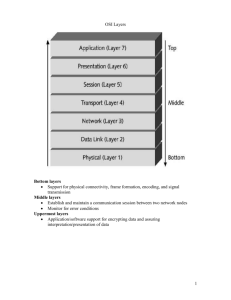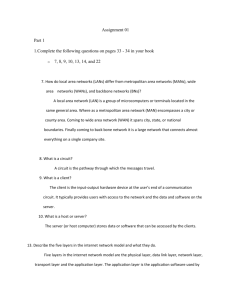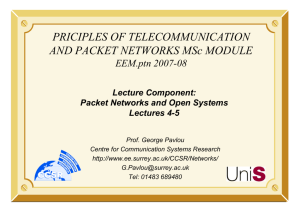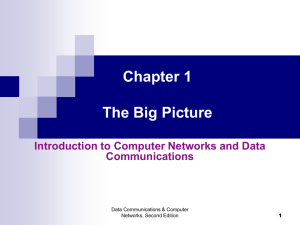Ans.Tutorial#2
advertisement
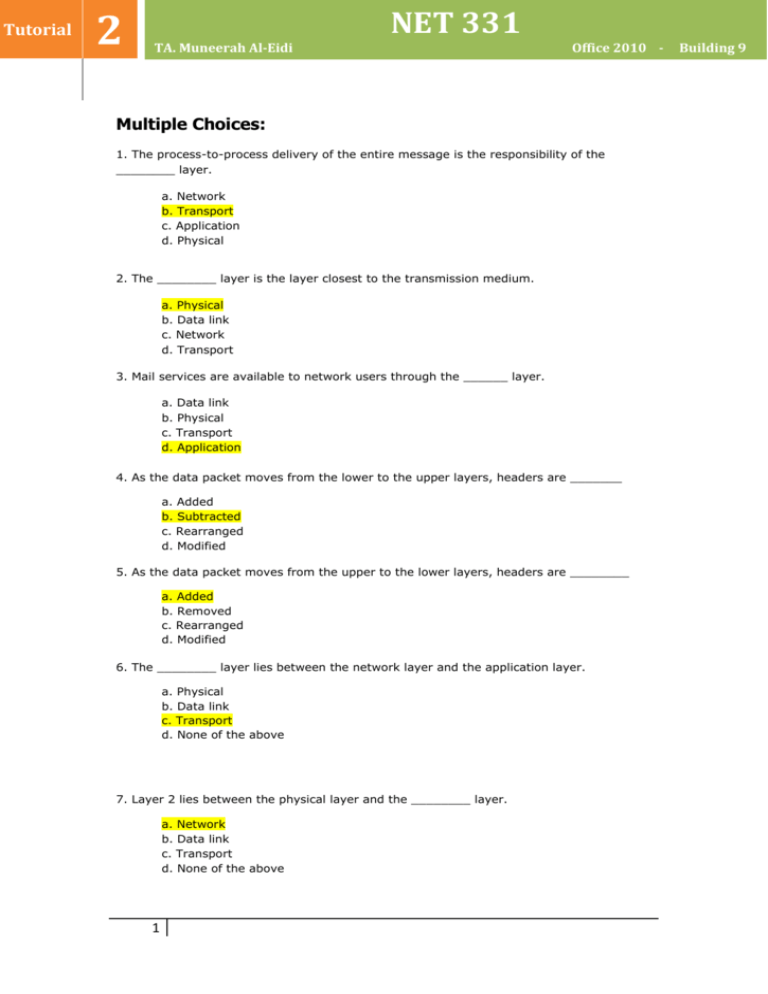
Tutorial 2 TA. Muneerah Al-Eidi NET 331 Office 2010 - Multiple Choices: 1. The process-to-process delivery of the entire message is the responsibility of the ________ layer. a. Network b. Transport c. Application d. Physical 2. The ________ layer is the layer closest to the transmission medium. a. Physical b. Data link c. Network d. Transport 3. Mail services are available to network users through the ______ layer. a. Data link b. Physical c. Transport d. Application 4. As the data packet moves from the lower to the upper layers, headers are _______ a. Added b. Subtracted c. Rearranged d. Modified 5. As the data packet moves from the upper to the lower layers, headers are ________ a. Added b. Removed c. Rearranged d. Modified 6. The ________ layer lies between the network layer and the application layer. a. Physical b. Data link c. Transport d. None of the above 7. Layer 2 lies between the physical layer and the ________ layer. a. Network b. Data link c. Transport d. None of the above 1 Building 9 8. When data are transmitted from device A to device B, the header from A’s layer 4 is read by B’s ________ layer. a. Physical b. Transport c. Application d. None of the above 9. The ________ layer changes bits into electromagnetic signals. a. Physical b. Data link c. Transport d. None of the above 10. The physical layer is concerned with the transmission of _______ over the physical medium. a. Programs b. Dialogs c. Protocols d. Bits 11. Which layer functions as a liaison between user support layers and network support layers? a. Network layer b. Physical layer c. Transport layer d. Application layer 12. What is the main function of the transport layer? a. Node-to-node delivery b. Process-to-process delivery c. Synchronization d. Updating and maintenance of routing tables 13. Which of the following is an application layer service? a. Remote log-in b. File transfer and access c. Mail service d. All the above Exercises (From the text book -Data communication and networking-) 15- How are OSI and ISO related to each other? The International Standards Organization (ISO) is a multinational body dedicated to worldwide agreement on international standards. An ISO standard that covers all aspects of network communications is the Open Systems Interconnection (OSI) model. 16- If the data link layer can detect errors between hops, why do you think we need another checking mechanism at the transport layer? The errors between the nodes can be detected by the data link layer control, but the error at the node (between input port and output port) of the node cannot be detected by the data link layer. 2 17- In Figure 2.22, computer A sends a message to computer D via LANl, router Rl, and LAN2. Show the contents of the packets and frames at the network and data link layer for each hop interface. 18- Suppose a computer sends a packet at the network layer to another computer somewhere in the Internet. The logical destination address of the packet is corrupted. What happens to the packet? How can the source computer be informed of the situation? Before using the destination address in an intermediate or the destination node, the packet goes through error checking that may help the node find the corruption (with a high probability) and discard the packet. Normally the upper layer protocol will inform the source to resend the packet. 19-Match the following to one or more layers of the OSl model: a. Communicates directly with user's application program application layer b. Error correction and retransmission data link and transport layers c. Mechanical, electrical, and functional interface physical layer d. Responsibility for carrying frames between adjacent nodes data link layer 20- Match the following to one or more layers of the OSI model: a. Establishes, manages, and terminates sessions session b. Format and code conversion services presentation c. Ensures reliable transmission of data data link and transport layers d. Log-in and log-out procedures session e. Provides independence from differences in data representation presentation 21- Suppose a computer sends a frame to another computer on a bus topology Local Area Network (LAN). The physical destination address of the frame is corrupted during the transmission. What happens to the frame? How can the sender be informed about the situation? If the corrupted destination address does not match any station address in the network, the packet is lost. If the corrupted destination address matches one of the stations, the frame is delivered to the wrong station. In this case, however, the error detection mechanism, available in most data link protocols, will find the error and discard the frame. In both cases, the source will somehow be informed using one of the data link control mechanisms discussed in Chapter 11. 22- In Figure 2.22, assume that the communication is between a process running at computer A with port address i and a process running at computer D with port 3 address j. Show the contents of packets and frames at the network, data link, and transport layer for each hop. 23- Match the following to one or more layers of the OSI model: a. Flow control data link and transport layers b. Route determination network layer c. Provides access for the end user application layer d. Interface to transmission media physical layer 24- Match the following to one or more layers of the OSI model: a. Transmission of bit stream across physical medium physical layer b. Defines frames data link c. Reliable process-to-process message delivery transport d. Route selection network e. Provides user services such as e-mail and file transfer application 25- Suppose a computer sends a packet at the transport layer to another computer somewhere in the Internet. There is no process with the destination port address running at the destination computer. What will happen? Most protocols issue a special error message that is sent back to the source in this case. 4

